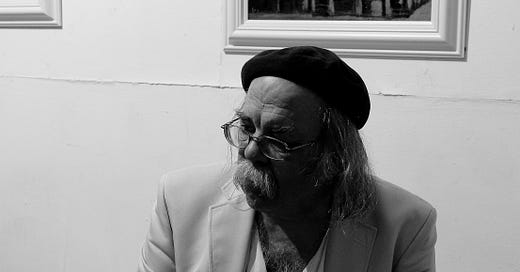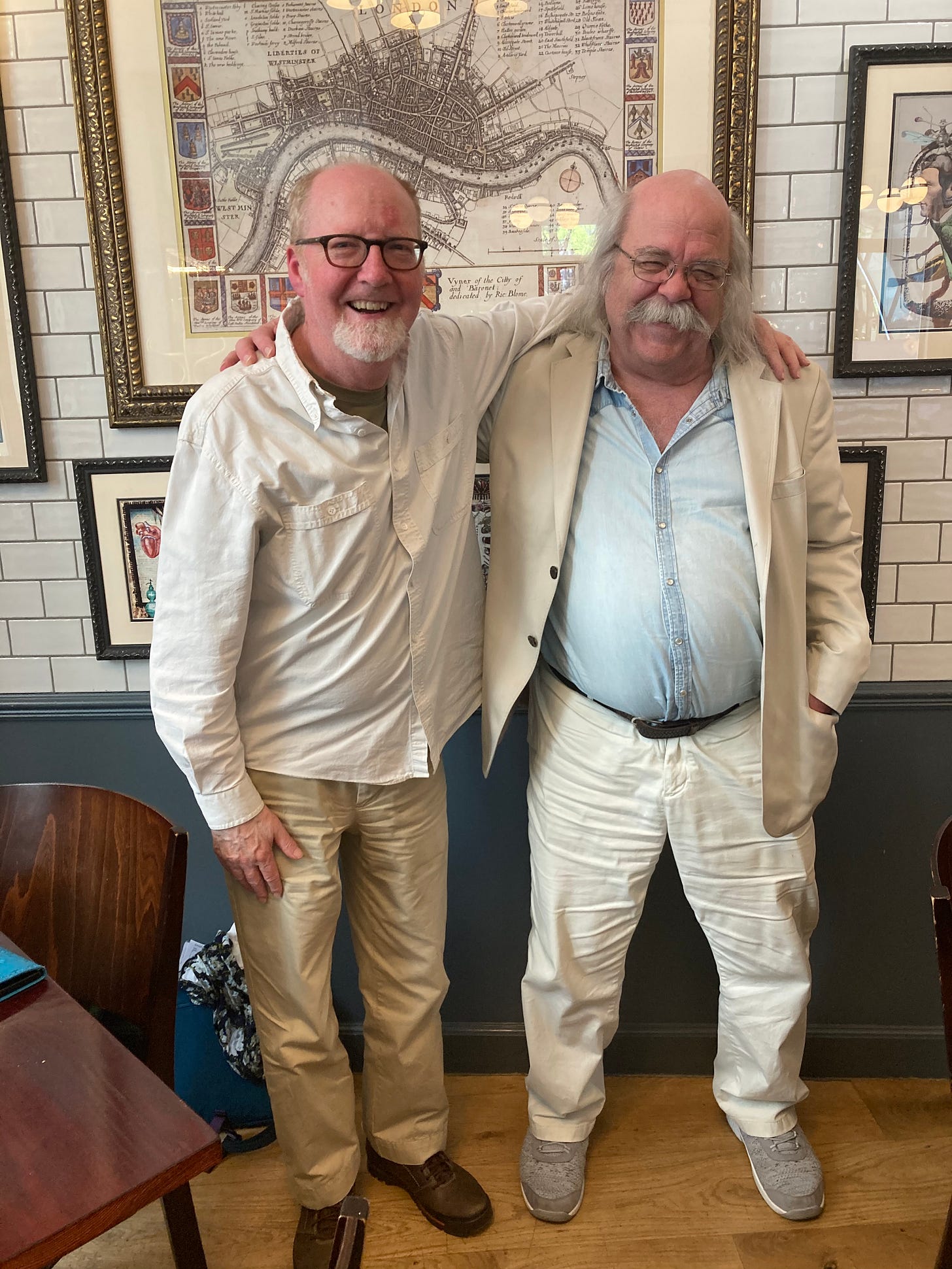Beat Soundtrack #20: Larry Beckett
In which prominent Beat figures, writers and critics, historians and academics, fans and followers, talk about the relationship between that literary community and music
Larry Beckett is an American poet, playwright, novelist, songwriter and literary critic. He has had several books of poetry and prose published including Songs and Sonnets, Beat Poetry, and the book-length poems, Paul Bunyan, Wyatt Earp, and Amelia Earhart, which were collected with seven others as the epic American Cycle, a 47-year project, published in April 2021 by Running Wild Press in Los Angeles.
All of American Cycle has been recorded in performance, and released in digital versions. Albums of his song lyrics include Goodbye and Hello and Starsailor by Tim Buckley, Pass Your Light Around by Jerry Yester, Love & Trial and The Accidental Falls by Eyelids.
Beckett is currently in Europe and, on June 24th, he will give an afternoon performance at the Cavendish Arms, Hartington Road, Stockwell, London, when guitarist Stuart Anthony will join him to perform work from their current recording Mirabeau Bridge.
What attracted you to the Beats? When did you first encounter them? Are you drawn to a particular text, novel or poetry?
At 13, in 1960, I was ripe for rebellion. In the bourgeois supermarket, on the bourgeois paperback rack, I saw the Feldman and Gartenberg anthology The Beat Generation and the Angry Young Men. It introduced me to Allen Ginsberg's ‘Howl’ and Jack Kerouac's On the Road, which were deeply inspired outlaw art, and turned out to be classics. I found the definitive collection A Casebook on the Beat, edited by Thomas Parkinson. I started writing free association poetry every day between junior high school classes.
I love the spring of this river, Jack Kerouac's spontaneous prose, and the street poetry of the San Francisco renaissance: Lawrence Ferlinghetti’s lyrical cityscapes, Kerouac’s blues and haikus, Ginsberg’s saxophone prophecies, Gregory Corso’s obsessive odes, John Wieners’ true confessions, Michael McClure’s physical hymns, Philip Lamantia’s surreal passions, Gary Snyder’s work songs, Philip Whalen’s loose sutras, Lew Welch’s hermit visions, David Meltzer’s improvisations and discoveries and Bob Kaufman’s jazz meditations. And this flowed on into LeRoi Jones, Diane di Prima, Jack Micheline, Ed Sanders and more.
Pictured above: Larry Beckett at the piano in the View Two Gallery in Liverpool
What is the relationship between the Beat writers and music?
Ezra Pound said 'poetry begins to atrophy when it gets too far from music.' But he and the other modernists ignored the warning, and went on publishing their academic verse in the literary reviews. Kerouac knew this, and wrote in Mexico City Blues, 'Cantos oughta sing'.
With the Beats, poetry is spoken, in the street, for everyone, with the fire of their own talk, and with all the music of language. In performance, it's been natural since the Greeks to accompany poetry with music. Ginsberg prophesied in ‘Howl’ how they were 'contemplating jazz', 'seeking jazz', and the 'jazz incarnation', 'and rose reincarnate in the ghostly clothes of jazz', in his breath stanzas, each like a 'saxophone cry'.
Kerouac kicked it off by giving the first New York poetry and jazz reading, at the Brata Art Gallery, doing San Francisco Blues to David Amram's music. Ferlinghetti recorded poems from A Coney Island of the Mind live with the Cellar Jazz Quintet. Kerouac recorded the masterful Blues and Haikus album with Al Cohn and Zoot Sims on sax. There's a version of Corso's Bomb orchestrated by Hal Willner. David Meltzer recorded Poet with Jazz with a pickup quartet. And Ginsberg later recorded ‘Howl’ with a string quartet, as composed by Lee Hyla.
Kerouac went further, and used music as a model for composing poetry. 'I want to be considered a jazz poet blowing a long blues in an afternoon jam session on Sunday.' This is impressive, but is it real? Composition by synesthesia, as if words were notes.
In a jazz performance in the early fifties, a soloist plays a theme and improvises variations on it, to a chord progression, in a time signature, for a number of measures, as backed by a rhythm section. Kerouac’s blues chorus is a brief private free verse lyric: what is the theme, where are the variations, harmonic structure, rhythm, measures, accompaniment?
In the preface to San Francisco Blues, he writes:
‘In my system, the form of blues choruses is limited by the small page of the breastpocket notebook in which they are written, like the form of a set number of bars in a jazz blues chorus, and so sometimes the word-meaning can carry from one chorus into another, or not, just like the phrase-meaning can carry harmonically from one chorus to the other, or not, in jazz, so that, in these blues as in jazz, the form is determined by time, and by the musician's spontaneous phrasing & harmonizing with the beat of the time as it waves & waves on by in measured choruses.
It’s all gotta be non-stop ad libbing within each chorus, or the gig is shot.’
The measures of the twelve-bar blues correspond to the measure of the length of the page of his pocket notebook, which holds one chorus, and the rhythm to the width of the page, which holds short free lines with two or so stresses. The theme is the view from the window of the cheap hotel on the northeast corner of 3rd and Harrison, across from the Belfast Building, and with the 'wildest bar in America', on Howard, in sight, and the choruses are variations on what he sees, whoever’s in the street, coming and going, like a rhythm section, always changing, and what he feels and dreams.
Pictured above: Larry Beckett, ‘It’s like the Kerouac and Cassady photograph.’ Simon Warner and Beckett together in London, June 2022
As a poet, lyricist and writer have you been shaped or influenced by Beat experiences?
As I said, ‘Howl’ lit a fire still burning. I've pored over poetry, Beat and classic, loved, memorised, recited, studied, analysed, internalised it, and every line I write is shaped by that language.
For example, after writing most of the long poems of American Cycle, and contemplating writing a beginning and ending, I thought of when I was rolling down the freeway back into Los Angeles after years away, and how those old off-ramp names, Sepulveda, Sunset, Figueroa, had stayed in my memory, like the names of rivers a century before. These highways are our rivers.
And then from On the Road I took the image of the American driver, and imagined him going north on Highway 1, and then west on Route 66, along the way encountering the next nexus, where history, legend, and song mysteriously cross, and I had US Rivers, to start and finish the epic.
Which musical artists from whichever era appear to make links with the Beat Generation – and how?
Each of us has our own answers to that, from what we've heard. Charlie Parker is out in front, the inventor of bop, perfect in improvisation, the star of the musicians of that time. Kerouac lifts Bird into divinity in Mexico City Blues. But Kerouac had a closer connection with the sax player Lee Konitz; his breakthrough into spontaneous prose, 'Blow as deep as you want to blow', was during a performance of ‘I'll Remember April’ by Konitz, as recorded in 'Journal 1951', included in Todd Tietchen's The Unknown Kerouac, and well explored by Marian Jago in 'Duet for Saxophone and Pen,' in Kerouac on Record, edited by Simon Warner and Jim Sampas.
The natural heir of the Beats is Bob Dylan, inspired by Mexico City Blues and friends with Ginsberg; this is well documented in Michael Goldberg's 'Bob Dylan's Beat Visions', also in Kerouac on Record. Except for the cascading rhymes and chorus-only melody, ‘It's Alright, Ma (I'm Only Bleeding)’ is Dylan reciting a Beat poem.
And, though Beat poetry is only one arc of the influences on my work, seven years after reading ‘Howl’, I was writing ‘Goodbye and Hello’, a long song like a poem, with countercultural themes. Later, I wrote a book nobody had written, Beat Poetry, an anthology of major poems with close readings.
Who are your own favourite singers, musicians and bands? Do they represent Beat ideas or attitudes in their lives and art?
That list's so long! This is the beginning of it: the composers, J. S. Bach, Charles Ives, the singers, Enrico Caruso, Elvis Presley, Fred Neil, Jean Redpath, the musicians, Miles Davis, Lennie Tristano, Pablo Casals, Ali Akbar Khan, and the bands, the Beatles, the Byrds, Bob Dylan and the Hawks, the Kronos Quartet.
Davis and Tristano don't compromise as artists; they are authentically themselves, like Kerouac and Ginsberg writing their unpublishable texts, and all are among my heroes. The fifties recordings of Miles, as in his album Kind of Blue, and Tristano, in Lennie Tristano, where the musical ambience feels like the Beat ethos, naked, off-beat, improvisatory, are a true Beat Soundtrack.
Note: Rock and the Beat Generation is home to other articles about Beckett – ‘Interview #3: Larry Beckett’, November 27th, 2021; ‘Radio review #1: “Song to the Siren”’, December 8th, 2021; ‘Radio date for McGough and Beckett’, January 9th, 2022; and ‘Muse and music: Bridging the gap’, May 26th, 2022






Wonderful interview and insights.